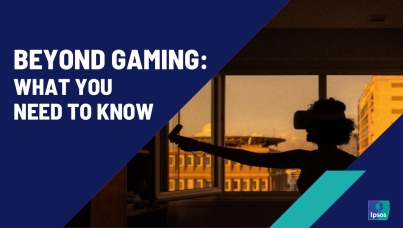Understanding child safety and video gaming with GameTrack
Use of communication features when playing video games
Ipsos has undertaken research on behalf of the Interactive Software Federation of Europe (ISFE) to explore how children aged up to 15 years old are using communication features when playing videogames and how parents are controlling and monitoring this online interaction to help safeguard their children. Questions were also asked to a sample of video game players aged 11-64 years old to better understand player behaviour overall.
Video games have played an important role in many people’s media habits over the past year. With people across the surveyed European markets confined to their homes during national and regional lockdowns, video games, as with other forms of media, provided entertainment and release. Previous research conducted on behalf of ISFE by Ipsos showed how at the start of the COVID-19 pandemic average time spent gaming increased across markets, making video gamers feel happier and more connected with their friends.
Online multiplayer video games in particular provided an important outlet for video gamers, with video games such as Fortnite and Roblox providing further experiences such as virtual concerts and movie screenings. With multiplayer video gaming becoming an important part of the video game industry and the media habits of younger people, this research focusses on these habits and how parents are helping to control and monitor their children’s gameplay and interactions online.
Online multiplayer videogaming is popular, but not all children play multiplayer online video games
Based on this current research, the large majority of parents (59%) claimed that their child did not play multiplayer online video games. Two fifths (41%) of parents with a child who play video games said they play online multiplayer games. The majority of these (85%) use some form of online communication feature to interact with their fellow players, including via communication features in the video game (57%), messaging apps such as WhatsApp (30%), third party sites such as Discord (26%) and social media sites such as Facebook (9%).
There is a high level of parental supervision, controlled use of online communication features and use of parental control tools
Where online communication features are used parents are monitoring them. Four in five parents (79%) who claim their child uses any form of online communication feature either supervises their child (46%), uses parental controls to monitor things such as friend requests and chats (36%) or has an agreement with them (33%).
According to parents, the incidences of children playing online multiplayer video games and being exposed to content from other players that might make them feel uncomfortable or upset is low. Three-quarters (75%) of parents with a child who plays online multiplayer videogames claimed they were not exposed to any of the listed behaviours, including for example harmful or bad language, bullying, and unwanted advances. Harmful or bad language was the most commonly reported behaviour, but just under one in 10 (8%) claimed their child had been exposed to this while playing video games. More serious behaviours such as explicit nudity (3%) and the encouragement of self-harming behaviour (3%) saw the lowest incidence.
According to a 2020 survey commissioned by the UK's Ofcom, compared to other sources such as social media, instant messaging, and video sharing, gaming sites or platforms were the least cited by respondents for potential harms, with 2% of adults and 3% of children experiencing such harms via online gameplay.
Parents take some form of action if their child is exposed to potentially harmful content when playing video games
Parents are taking action following reported incidents of potentially harmful content in video games, with the most common actions reported being speaking to family, reporting potentially harmful content via built-in reporting mechanisms in video games, and speaking to friends. Almost all parents (96%) who claimed their child had been exposed to potentially harmful content took at least one of the listed actions.
Similar trends are seen among players, with players taking action when they are exposed to potentially harmful content
Communication features are popular among players aged 11-64 years old, with seven in 10 players who play online multiplayer videogames using features in the video game, messaging apps, third party sites or social media to talk to other players. Though incidences of being exposed to potentially harmful content when playing video games are low, according to players (78% claimed they had not been exposed to such behaviour), players are acting when they are exposed to this type of content by other players. When compared to the parents surveyed, players were more likely to use reporting systems built into video games (38%).

Methodology
Fieldwork took place between November 2020 and January 2021 via an online survey conducted by Ipsos on behalf of the Interactive Software Federation of Europe (ISFE). Parents of children aged up to 15 years old who play any type of videogame on any device were surveyed in Great Britain, France, Germany, Spain and Italy with a total base across markets of n=908. Full details can be found in the linked report.
Technical note
You can view the technical note here.





